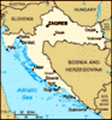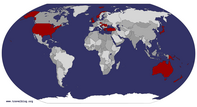Advertisement
Published: April 29th 2015
We left Brasov, Romania about 1 week ago and since then we’ve spent most of our time in Dubrovnik and Split, Croatia. We travelled from Brasov to Bucharest by train. The train trip was quite enjoyable and we passed through picturesque mountainous regions covered in freshly fallen snow, agricultural land where apiarists were camping out by their hives and after 3 hours or so we reached Bucharest. Gary and Oana met us at the station and from there we returned to “our” apartment before joining Oana’s family for lunch. Despite the fact that we were taking everyone out for dinner that night, Oana’s mum decided that we needed to be fed. Soup and/or sandwich you might think. Soup yes, followed by cheese pastries and then a roast chicken, roast potatoes and a salad. Dessert was probably offered but we all declined. Dinner that night was at a restaurant called Hanu’ Berarilor (Casa Elena Lupescu) which is located in the mansion that King Carol II built for his mistress. Carol II ended up divorcing his first wife, abdicating and marrying this lady.
The next day we flew from Bucharest to Dubrovnik via Vienna. We were met at the airport by the

 Dubrovnik Old Town
Dubrovnik Old Town
View from our apartment balconyowners (Duda and Pavo) of the apartment that we had booked, driven to a supermarket for breakfast supplies and a coffee before being driven to the apartment. The apartment was on the 3
rd floor and up 100 steps so we were fortunate to have Pavo help carry our bags up for us. Our apartment was small and self-contained, about a 10 minute walk from the touristy bit of Dubrovnik - it had lovely views towards the old town and over the island of Lokrum. In fact the views were so good that the Croatian military forces took over the apartment for use as an observation post during the 1991 Homeland War with Yugoslavia-Bosnia. That afternoon we walked into the old town to get our bearings and to have an early dinner. It was a lovely warm and calm evening and the air was perfumed with orange blossom from the orange trees growing in the old moat.
We commenced our tourist-work the next day. On the first day we caught the local bus to the intercity bus station to find out the departure timetable to Split and then walked back to the old town. It doesn’t sound all that exciting

 Dubrovnik
Dubrovnik
Steep back streetsI guess but it was interesting to see some of the older housing outside the city walls, see the new harbour and enjoy the views along the cliff tops. We managed to get caught in the rain and on arrival back in the old town after lunch it was raining again but that didn’t put us off too much. We visited a few of the historic sites, including the cloisters of the Franciscan Monastery, a couple of churches and the Rectors House, and spent the rest of our time literally walking up and down the back streets of Dubrovnik. On Day 2 we rose “early” and walked into old town so that we could enjoy the environment with fewer tourists. After an hour or so of walking around we had some breakfast and then purchased tickets to walk the walls. I think that this would have to have been my favourite activity during our 3 days in Dubrovnik. The views over the coastline and old town are amazing and it is only from up here that you get to appreciate the damage inflicted on the town during the Homeland War. A very large portion of the old town was destroyed

 Dubrovnik
Dubrovnik
St Blaise Church and Orlando's Columnby fire during this war and the extent of those fires is evident in the new terracotta tiled roofs. The reconstruction of old buildings and walls has been very well done with lighter stone being the only tell-tale sign.
On our final day we woke to find a small cruise ship parked outside our balcony with its tenders ferrying the passengers backwards and forwards to the old harbour or over to the island of Lokrum. That day we decided to take the cable car to the top of Mt Srd, visit the Homeland War Museum and then walk back down the mountain to the old town. As expected, the views over Dubrovnik and surrounds were pretty spectacular. The Homeland War Museum was interesting and I found it interesting to compare the wartime photos with the images that I was taking home – it’s impossible to imagine what life must have been like during those few years. Not surprisingly, the Homeland War is such a major part of recent Dubrovnik life that I have little feel for the earlier history of the town. Perhaps that would have been rectified if we had participated in a guided town walk. The walk

 Dubrovnik
Dubrovnik
Orlando's Columndown from Mt Srd was quite pleasant with the hills covered in yellow flowering shrubs that look a bit like broom, some sweet purple-blue flowers, thyme, and purple-flowering iris. When we arrived back in old town the place was packed compared to our previous days; presumably the fact that it was Sunday meant that locals were out enjoying themselves and no doubt the cruise ship passengers were helping to swell the numbers. I can’t imagine what it must be like in “the season” when there can be 4-6 cruise ships in town plus all the accommodation is full – it must be bedlam.
We caught the bus from Dubrovnik to Split arriving at our accommodation after five and a half hours of bus travel – we did have a 15 minute stop at the 4.5 hour mark. I don’t think that I’ve ever experienced a bus trip quite like this one. The bus didn’t just pick up and put down passengers at main bus stations; it also stopped at small bus shelters in the middle of nowhere. It seemed to me that locals were catching the bus to go shopping and school kids were definitely using it to return

 Dubrovnik
Dubrovnik
Stradun - the main streetfrom school. The trip itself was spectacular. The first part was along steep cliffs and followed a very winding coastline with islands offshore. After crossing the Bosnia and Herzegovina zone we entered a huge fertile river delta where they seemed to be growing oranges, olives and other crops that we could not identify. Afterwards we were in the Dalmatia region of Croatia with the landscape characterised by the incredibly steep mountains seeming to rise straight from the sea. Eventually we travelled along a narrow coastal plain strung with beachside tourist towns before finally arriving in Split mid-afternoon.
Split is the second largest city in Croatia and seems to be comprised of a modern commercial section and the old town which has grown up around the once heavily fortified Diocletian’s Palace. Our apartment was an easy 10 minute walk from the bus station and almost opposite the Silver (Eastern) Gate of the Palace. We were both pretty tired from our travel so just wandered around the old town before dinner. Our sightseeing started in earnest the following day. This time we hired a guide for a 90 minute walking tour of the old town and he told us a lot

 Dubrovnik
Dubrovnik
The Rector's Palaceabout the history of the town. Split has grown up around the old Roman Diocletian’s Palace built by the Emperor Diocletian between 295 and 305 AD. Apparently Diocletian wasn’t aristocratic by birth, instead he was the son of a freed slave. He was ambitious, smart and a great army tactician and so quickly made his way through the army ranks. He was declared emperor when he defeated the previous emperor’s son in battle after that guy’s father died. He is known for dividing the huge Roman Empire into 4 sub-empires that were ruled by another 3 co-emperors and for creating a large bureaucracy. In 305 AD Diocletian abdicated due to poor health and saw out the rest of his days at his brand new palace in what is now Split. He had a few good ideas and reformed and stabilised the empire both economically and militarily. However, he followed Roman rule which wasn’t particularly tolerant to the early Christians, thus he persecuted them in line with previous Roman emperors. He eventually died in 311 AD after spending his retirement tending his vegie garden at the palace. Diocletian was interred in a sarcophagus that was placed in the centre of the

 Dubrovnik
Dubrovnik
Views from the walloctagonal mausoleum that is now part of the cathedral. When the Christian population eventually rose to prominence they decided to turn the mausoleum into a cathedral and so added new bits, including the bell tower, to enlarge it. They had such a dislike for Diocletian because of the persecution that they had suffered at his hand and so, we were told, they took revenge by destroying his sarcophagus and using the rubble in the construction of the Cathedral’s alter. During our guided tour and later ambles we saw the well preserved basement area of the palace, the remains of the emperors walk, heard about the use and need for vomitoria, visited the cathedral/mausoleum, climbed the bell tower for views over town and walked to the top of the hill adjacent to old town. Over the years the old town has been used as a palace by Diocletian, 300 years later it was taken over by the native Croats who used the fortifications to escape various invaders and afterwards there were invasions by the Venetians, Austro-Hungarian Hapsburgs, French etc. Various well-to-do merchants from the Middle A
ges built their palaces/mansions right up to the original Roman columns (imported from Egypt each weighing

 Dubrovnik
Dubrovnik
Views from the walls looking east towards our apartment7.5 ton) and these ancient columns are now incorporated into the facades of the mansions. Because of the continued use and habitation of the palace precinct the original Roman design has mainly disappeared and has been replaced with a network of very narrow streets and laneways and multi-storey buildings that now house family apartments, restaurants, shops and banks. The old stonework of the palace has been cleaned in places. They don't use sand blasting as that removes the surface, instead the cleaning is done using lasers.
We’ve now left Split and had another 5 hour bus ride to find ourselves in Plitvice Jezera ready to explore the nearby National Park tomorrow.
Advertisement
Tot: 0.146s; Tpl: 0.017s; cc: 13; qc: 53; dbt: 0.0501s; 1; m:domysql w:travelblog (10.17.0.13); sld: 1;
; mem: 1.2mb





















